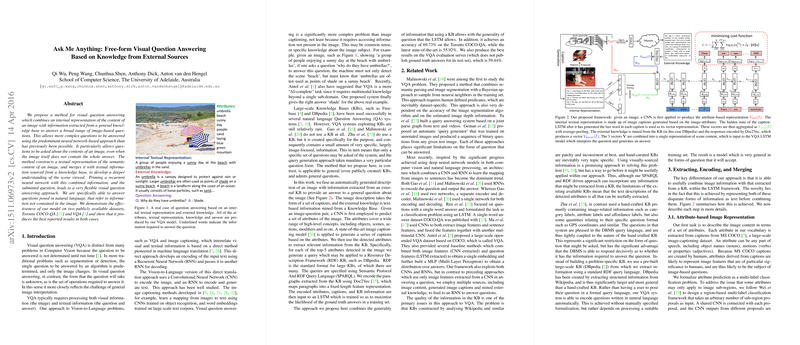Overview of "Ask Me Anything: Free-form Visual Question Answering Based on Knowledge from External Sources"
This paper presents a novel approach for Visual Question Answering (VQA) that merges image content with external semantic knowledge to answer complex visual questions. Traditional VQA challenges are amplified by the unpredictability of both question formulation and the operations needed for responses. Existing systems often rely solely on internal image representations without leveraging auxiliary knowledge, which can restrict their ability to tackle questions necessitating broader contextual understanding.
Methodological Framework
The core advancement of this research is the integration of a textual image representation with external knowledge to improve VQA. The method employs a recurrent neural network (RNN), primed with information derived from both the image and a general knowledge base. This setup allows the model to respond to free-form, natural language questions about image content, even when critical information is absent from the image itself.
The proposed method involves three primary components:
- Attribute-Based Image Representation: Images are decomposed into high-level semantic attributes using convolutional neural networks (CNNs). This multi-label classification approach detects objects, scenes, actions, and other relevant concepts within an image.
- Caption-Based Image Representation: With an attribute-based image description, the model generates multiple image captions via an LSTM model. These captions form an internal textual representation that aids in understanding the image in a human-annotated context.
- Knowledge Base Integration: The model dynamically queries an external knowledge base (e.g., DBpedia) using SPARQL, retrieving textual information that complements the internal image description. This feature is designed to bridge informational gaps present in image data alone.
Evaluation and Results
Empirical results demonstrate the superiority of this method on two datasets: Toronto COCO-QA and VQA. The proposed model achieves an accuracy of 69.73% on Toronto COCO-QA, surpassing the state-of-the-art by a significant margin, and 59.44% on VQA. Notably, the model excels in scenarios where questions necessitate information beyond visual content, such as common sense or domain-specific knowledge, thus advancing the model as an "AI-complete" solution.
Implications and Future Directions
The implications of this research are multifold. Practically, it illustrates a substantial improvement in VQA systems by incorporating extensive knowledge bases, suggesting a trajectory toward more human-like image understanding capabilities. Theoretically, it emphasizes the need for multimodal approaches, combining visual and semantic processing to solve complex AI tasks.
Future research could explore adaptive knowledge querying methods to tailor information retrieval to the specific demands of each question. Additionally, aligning image attributes more closely with narrative constructs could further refine the model's interpretative prowess. As larger and more comprehensive knowledge bases become available, the potential for even more sophisticated VQA systems grows, promising further advancements in artificial intelligence.
